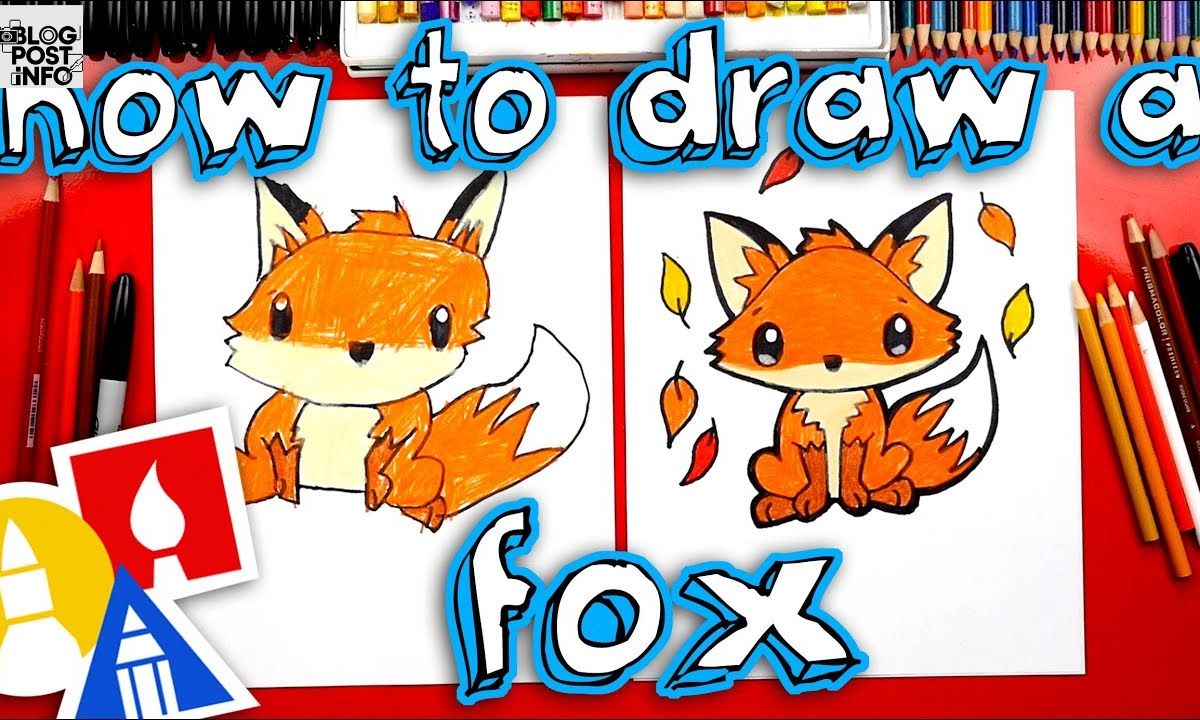Drawing a fox can be a fun and rewarding experience, especially for beginners. Start by breaking down the fox’s body into simple shapes, like ovals and circles, to map out its proportions.
Focus on the fox anatomy for artists to understand how the body parts connect. Once you have the basic structure, you can add details such as the ears, eyes, and tail.
For a more realistic drawing, practice pencil techniques for animals like shading and texture. Pay close attention to the direction of the fur and use light, gradual pencil strokes.
Getting Started with Drawing: Fox: The Basics
Before starting any drawing, it’s essential to gather your drawing supplies. Basic supplies include pencils, erasers, sketchbooks, and shading tools. Using a light pencil to outline shapes is the best approach for beginners.
The next step is to work on fox anatomy for artists, ensuring your fox has realistic body proportions. A good drawing always starts with a foundation of well-drawn skeleton and muscle structures.
Once you’ve laid down the framework, begin sketching the fox’s face, eyes, and ears. The key to making your drawing look lifelike is practicing shading and texture in art. Use varying pencil pressures to add depth and dimension.
Essential Supplies for Drawing: Fox

To create a beautiful fox drawing tutorial, you’ll need the proper materials. High-quality drawing paper is crucial as it will withstand erasing and shading without tearing. A set of graphite pencils in various hardness (from 2H to 6B) will help you achieve a range of shading effects.
You’ll also want a kneaded eraser to gently lift out highlights and details.Another essential tool is a blending stump, which helps smooth out pencil strokes to create realistic fur textures. Colored pencils can be used if you want to add color to your fox coloring techniques.
A sharpener is also necessary to maintain a fine point on your pencils for detailed work, especially when focusing on details like the fox’s tail and fur texture.
Step-by-Step Guide to Drawing: Fox
Start by outlining the fox body proportions with light lines, making sure to adjust the size and placement of the limbs and tail. Use a reference to study the fox anatomy drawing guide and ensure the anatomy is accurate.
Draw the fox’s head by focusing on the proportions of the ears, eyes, and snout. Drawing fox face details is essential for capturing its personality.Next, begin adding shading to the fox’s body using soft pencil strokes.
Shading and texture in art will bring your fox to life. Pay attention to how light hits the fur and use different techniques to create realistic fur texture. Work on defining the fox’s eyes, capturing their expressive animal eyes in drawing. The final step involves adding highlights and refining details until the fox looks truly lifelike.
Tips for Making Your Drawing: Fox Look Lifelike
To make your fox drawing look more realistic, you need to focus on texture. Use pencil techniques for animals such as layering light strokes to build up the texture of the fur. How to draw fur with pencil requires practice, as you need to vary the direction of the strokes to match the flow of the fox’s fur.
It’s also essential to observe how shadows fall on the fox’s body to add depth.One of the best tips for creating a lifelike drawing is to pay close attention to the fox’s eyes. Adding detail to the eyes can breathe life into the animal.
Use a mix of light and dark shading around the eyes to create a glowing, expressive look. If you are working on a colored fox drawing, focus on fox coloring techniques that mimic the natural hues of fur.
How to Add Color to Your Drawing: Fox
Adding color to your fox sketches and illustrations can make them pop. Fox coloring techniques typically involve using warm tones like orange, red, and brown. Use colored pencils or watercolor pencils to add layers of color. Start with a light layer of color and build it up gradually.
Pay attention to the subtle color changes on the fox’s fur, like the shift from lighter to darker shades around the paws and tail.When coloring a fox, be sure to add highlights to the areas where the light hits its fur, such as the tips of the ears or the belly.
Realistic fox art often involves blending colors to create smooth transitions, making the drawing feel more three-dimensional. Don’t forget the fox tail drawing techniques to ensure it looks full and fluffy.
Read This Blog: Sulayman Chappelle: Biography, Height, Weight, Net Worth, and Facts About Dave Chappelle’s Son
Fun Techniques for Shading Your Drawing: Fox

Shading is a crucial aspect of drawing a realistic fox. Shading and texture in art allow you to create depth and make the fox appear lifelike. You can use techniques like cross-hatching to build up shadows in the fox’s fur.
Light pencil strokes will create a soft, natural look, while darker strokes can be used to add definition to the face and body.Use a blending stump to smooth out the transitions between light and dark areas.
When you’re working on the fox body proportions, remember that the tail and legs often require more shading to give them dimension. To capture the texture of the fur, consider adding pencil techniques for animals, such as fur lines that curve in the direction of the hair growth.
Creating Texture: How to Draw Realistic Fur on Your Fox
To draw realistic fur on your fox, focus on using fine, short pencil strokes that follow the natural flow of the fur. Drawing fur with pencil is all about layering and varying your pressure to create depth.
Begin with a light outline of the fur, and slowly build up darker layers as you go along. Fox drawing mistakes to avoid include drawing fur in straight lines, which can make it look unnatural.
Use a blending stump to soften and smooth out the texture of the fur, but be careful not to over-blend. To add realism, observe how fur looks in real life and replicate its softness and flow. With practice, you’ll be able to achieve a detailed, textured fur look on your fox body proportions.
Drawing Fox Expressions: Capture Their Emotions
The fox’s face is a key component of conveying its personality. Fox expression drawing is all about observing the small details in its facial features, like the angle of the ears or the shape of the eyes.
Foxes are often portrayed as curious or alert, so focus on capturing these emotions in your sketches.For instance, if you want your fox to look curious, draw its eyes wide open and ears perked up.
The mouth can be slightly open to add to the expression. Detailed drawing expressions are crucial for bringing life to your art, especially when focusing on the eyes, which should reflect the emotion you’re trying to convey.
Using References for Drawing: Fox
To improve your drawing, always use references for drawing. Study pictures of real foxes to understand their anatomy and features. Fox anatomy for artists can be tricky, so reference images can help you understand how their body moves and how their fur lays. By looking at various angles, you’ll be able to recreate a more accurate and detailed drawing.
Using references will also help you with fox tail drawing techniques, as the tail is often one of the most difficult parts to get right. Always keep an eye on the way the fur flows and changes direction, as this adds a realistic feel to your artwork.
Exploring Different Styles in Drawing: Fox
Experimenting with different drawing styles can be an exciting part of creating fox sketches and illustrations. Whether you choose a realistic style or opt for something more cartoonish, try to infuse your drawings with your unique artistic voice.
If you’re interested in fox character design, try turning the fox into a fun, stylized version that reflects your personal style.Incorporating elements like nature-inspired drawing styles or advanced animal drawing techniques can add flair to your fox illustrations. The more you practice, the more you can explore new techniques that will make your drawings stand out.
Common Mistakes in Drawing:1enzi6g2cvg= Fox and How to Fix Them

One common mistake in fox drawing is not getting the fox anatomy for artists right, leading to unrealistic proportions. It’s important to break down the fox’s body into basic shapes before adding details.
Another mistake is incorrect fur texture. How to draw fur texture can be tricky, but using soft, varied pencil strokes and layering gradually will help you achieve a realistic look. Keep practicing pencil techniques for animals to refine these areas.
Why Drawing:1enzi6g2cvg= Fox is Great for Your Creativity and Relaxation
Drawing a fox is an excellent way to boost your creativity and relaxation. It allows you to explore nature drawing inspiration while improving your animal drawing skills.
Whether you’re practicing fox expression drawing or learning how to add shading in drawings, the process helps you develop new techniques and discover personal artistic style. Working on fox sketches and illustrations not only improves technical skills but also calms the mind, offering a therapeutic outlet to express yourself through art.
Frequently Asked Question
What’s the best way to start drawing a fox for beginners?
Begin with simple shapes and basic fox anatomy to form a solid foundation.
How can I make my fox’s fur look more realistic?
Use layered pencil strokes and vary your pressure to create texture and depth.
What colors should I use for a realistic fox drawing?
Use warm tones like red, orange, and brown for the fur, with white and black for highlights.
How do I draw a fox’s face accurately?
Focus on the placement and proportions of the eyes, nose, and ears.
What’s the secret to drawing expressive fox eyes?
Pay attention to light and shadow around the eyes to create emotion and depth.
Conclusion
Drawing a fox allows you to refine your drawing techniques for beginners while exploring new artistic possibilities. By practicing the fox anatomy drawing guide and using techniques like shading and texture in art, you’ll develop a greater understanding of animal forms.
Whether you’re working on realistic fox art or experimenting with fox character design, the journey will significantly enhance your artistic skills and provide a fulfilling and relaxing experience.

Fatima is a talented content writer and digital marketer with expertise in SEO, social media management, and online marketing.










